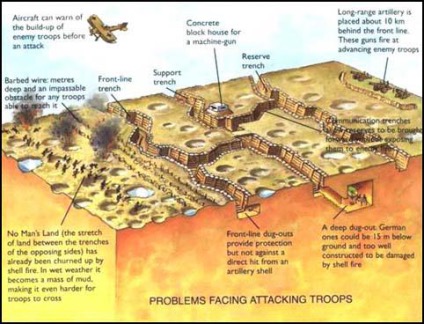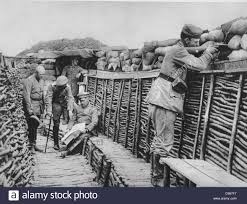1917: Year of stalemate. In 1917, Germany adopted a defensive strategy on the Western Front to counter the growing strength of the Allies. Despite launching several offensives, and suffering heavy casualties, the Allies achieved mixed results. A breakthrough remained elusive, but experiments in new fighting methods hinted at a possible end to
Strategic Command WW2 – War in Europe PC Game Review – A Wargamers Needful Things
There was deadlock on the Western Front due to a number of factors: The failure of the Schlieffen Plan. As the Germans failed to advance, they dug in at places which were difficult to attack. The strength of defences. Trenches were difficult to attack, especially as barbed wire and machine guns were used in defence. Ineffective weapons.

Source Image: sutori.com
Download Image
GCSE History Why was their stalemate on the western front? There are many different perspectives to the question above. However it is clear that the reason for the stalemate weighs heavily on the role of the Generals as well as other factors including technology and other fronts.

Source Image: sutori.com
Download Image
Why did stalemate develop on the western front? – A-Level English – Marked by Teachers.com
Oct 22, 2023WWI: Month-by-Month Timeline (1915-1916) At the start of 1915, World War I had settled into the stalemate of trench warfare on the Western Front. The German command switched their focus to the Eastern Front while defending their occupied territory on the Western Front. Throughout the period of 1915-1916, more countries joined the conflict

Source Image: markedbyteachers.com
Download Image
Why Did A Stalemate Develop On The Western Front
Oct 22, 2023WWI: Month-by-Month Timeline (1915-1916) At the start of 1915, World War I had settled into the stalemate of trench warfare on the Western Front. The German command switched their focus to the Eastern Front while defending their occupied territory on the Western Front. Throughout the period of 1915-1916, more countries joined the conflict
The term ‘Stalemate in WW1′ is used to describe a period in the Great War where neither the Allies nor the Central Powers could gain a decisive advantage over the other on the Western Front. This deadlock resulted in a war of attrition, marked by trench warfare and limited territorial gains for huge human cost.
Why did a stalemate develop on the western front? – GCSE History – Marked by Teachers.com
The Western Front became a stalemate because the German Schlieffen Plan was not carried out well enough to overrun France before the French could get their defenses settled, and because once
World War I: An Overview of 1915
:max_bytes(150000):strip_icc()/GettyImages-3279916-5c3789d046e0fb000119448f.jpg)
Source Image: thoughtco.com
Download Image
Why was there stalemate on the western front | PPT
The Western Front became a stalemate because the German Schlieffen Plan was not carried out well enough to overrun France before the French could get their defenses settled, and because once

Source Image: slideshare.net
Download Image
Strategic Command WW2 – War in Europe PC Game Review – A Wargamers Needful Things
GCSE History Why was their stalemate on the western front? There are many different perspectives to the question above. However it is clear that the reason for the stalemate weighs heavily on the role of the Generals as well as other factors including technology and other fronts.

Source Image: awargamersneedfulthings.co.uk
Download Image
Why did stalemate develop on the western front? – A-Level English – Marked by Teachers.com
1917: Year of stalemate. In 1917, Germany adopted a defensive strategy on the Western Front to counter the growing strength of the Allies. Despite launching several offensives, and suffering heavy casualties, the Allies achieved mixed results. A breakthrough remained elusive, but experiments in new fighting methods hinted at a possible end to

Source Image: markedbyteachers.com
Download Image
4 MAIN Causes of World War I – Built up for decades before ppt download
Coursework Assignment 1. The First World War. Why did a stalemate develop on the Western Front? A stalemate developed on the Western Front for four main reasons, one being that the Schlieffen plan failed, another reason was that the French were unable to defeat the Germans completely at the Battle of the Marne, another reasons was the “race to the Channel” and the last reason was that

Source Image: slideplayer.com
Download Image
Why did a stalemate occur on the Western Front? – A-Level History – Marked by Teachers.com
Oct 22, 2023WWI: Month-by-Month Timeline (1915-1916) At the start of 1915, World War I had settled into the stalemate of trench warfare on the Western Front. The German command switched their focus to the Eastern Front while defending their occupied territory on the Western Front. Throughout the period of 1915-1916, more countries joined the conflict

Source Image: markedbyteachers.com
Download Image
Why did a stalemate develop on the Western Front? – GCSE History – Marked by Teachers.com
The term ‘Stalemate in WW1′ is used to describe a period in the Great War where neither the Allies nor the Central Powers could gain a decisive advantage over the other on the Western Front. This deadlock resulted in a war of attrition, marked by trench warfare and limited territorial gains for huge human cost.

Source Image: markedbyteachers.com
Download Image
Why was there stalemate on the western front | PPT
Why did a stalemate develop on the Western Front? – GCSE History – Marked by Teachers.com
There was deadlock on the Western Front due to a number of factors: The failure of the Schlieffen Plan. As the Germans failed to advance, they dug in at places which were difficult to attack. The strength of defences. Trenches were difficult to attack, especially as barbed wire and machine guns were used in defence. Ineffective weapons.
Why did stalemate develop on the western front? – A-Level English – Marked by Teachers.com Why did a stalemate occur on the Western Front? – A-Level History – Marked by Teachers.com
Coursework Assignment 1. The First World War. Why did a stalemate develop on the Western Front? A stalemate developed on the Western Front for four main reasons, one being that the Schlieffen plan failed, another reason was that the French were unable to defeat the Germans completely at the Battle of the Marne, another reasons was the “race to the Channel” and the last reason was that